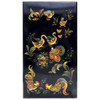Product Description
Barnyard Fowl (Живность скотного двора). An interesting Mstera painting on a large (12" x 6½") papier-mache panel (pano). Signed in the bottom left hand corner with the initials of the artist and "Мстера". A dynamic and colorful egg tempera painting show geese and chicks, chicken and rooster, an impressive turkey and two cocks in the middle of a fight. Circa 1970-1980. In very good condition with a couple of small dings but nothing more. A collectible piece. 1 only, as shown.
Mstera, or Mstyora (Мстёра) miniatures are different from Palekh and Kholui miniatures, though, on first glance, they all can seem the same. Generally, Mstera painters chose a solid color background for their work, and seldom black, which is preferred in Palekh. The village of Mstera is located in the center of the Vladimir-Suzdal province on two rivers. The landscape of the village is reflected in the fields and foliage of many Mstera boxes. The first mention of Mstera goes back to 1609, whose artists excelled in embroidery, silver and copper metalwork and icons and frescoes. By the end of the 19th century, icon painting was first and foremost in Mstera (the name of the village derives from Masters). An artel of "Old Russian Painting" was organized in Mstera in 1923. However, since icons were no longer painted due to repression of the church by the government, the artists mastered painting on papier-mache boxes, which are more durable than wood. Genuine Mstera miniatures take a long time to make, as the work is piecemeal. The result is a work of art. Linseed oil, aka flaxseed oil, is used in the production of the boxes, which are lacquered and polished at least seven times. In 1932 the artel was transformed into the "Proletarian Art" factory. As of 2017, there were only about three dozen artists left in Mstera, indicating the serious threat of extinction for this traditional art.









![Ruslan Battles the Giant Head [Mstera] Ruslan Battles the Giant Head [Mstera]](https://cdn11.bigcommerce.com/s-kgl10g/images/stencil/500x659/products/3793/35070/Ruslan_Head_Mstera_1__33170.1639015142.jpg?c=2)

![Deux Danseuses sur la Scene [Degas] Unframed Masterpiece Replica Painting Deux Danseuses sur la Scene [Degas] Unframed Masterpiece Replica Painting](https://cdn11.bigcommerce.com/s-kgl10g/images/stencil/500x659/products/4163/38857/abb__29710.1662664655.jpg?c=2)